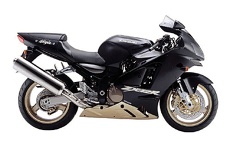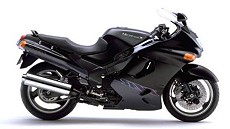Visit the old website: |
Suzuki Hayabusa Stuff:  Tech Specifications Tech Specifications Color Schemes |
Featured story lines: LAMS and Commuter motorcycles Motorcycle Picture Galleries Motorcycle Specs and Pricing |
Kawasaki ZX-12R Ninja review
 Kawasaki ZX-12R Ninja – Specifications and History: This article is about the Kawasaki ZX-12R Ninja (this was the fastest motorcycle from Kawasaki) – in case you’re new to motorcycles or simply forgotten – it was the arch-rival for the Hayabusa. Specifications for the ZX12R listed here are primarily from the initial release but I have indicated any known changes in the list as well. I have also included my little story of what I know of the bike as it passed through the years. I recommend trying the bike out for your self before concluding rather than relying opinions from the internet. There are still plenty of ZX sites so don’t despair just yet!
Kawasaki ZX-12R Ninja – Specifications and History: This article is about the Kawasaki ZX-12R Ninja (this was the fastest motorcycle from Kawasaki) – in case you’re new to motorcycles or simply forgotten – it was the arch-rival for the Hayabusa. Specifications for the ZX12R listed here are primarily from the initial release but I have indicated any known changes in the list as well. I have also included my little story of what I know of the bike as it passed through the years. I recommend trying the bike out for your self before concluding rather than relying opinions from the internet. There are still plenty of ZX sites so don’t despair just yet!
I resisted doing anything on this particular motorcycle in the past (till about 2008) because I didn’t want to sit on the fence with any comment – but mostly I didn’t want to get any more anti-hayabusa mail. So now that the ZX12 is gone and over the years I don’t particularly care about small minded people emailing – since I get them anyway especially from the pro-car lobby. Getting a ‘customised’ book when you bought a ZX12 does not mean its a great motorcycle in fact – as many ex-ZX owners tell me you’ve been conned by marketing not what a better motorcycle. Regardless I also wanted to people not to forget the the ZX despite its flaws was one of the great motorcycles of the new century.
Back in 1999 Kawasaki intended to release it’s replacement for the ZZ-R1100 or ZX-11 Ninja and in all honestly this was the motorcycle I was going to get next (after my foray in 600cc) this was because I’ve always wanted the last of the 1100 series.
 On the left is a picture of the ZZR-1100 otherwise known as the ZX-11 in the flesh it had real presence. Lovely and a classic.
On the left is a picture of the ZZR-1100 otherwise known as the ZX-11 in the flesh it had real presence. Lovely and a classic.
Suzuki released the Hayabusa first and it was reported by the media from the first lot of tests that it was faster and certainly better than what Kawasaki had originally planned for the ZX-12. Kawasaki delayed the launch of the ZX-12 by about 6 months. Why? it is assumed that they needed to improve specs to be Hayabusa competitive. I think the real reason for the delay has been forgotten over time, but honestly when you rode one you can tell that it was half finished effort.
When the ZX was finally released there were a massive number of performance tests between the ZX and all the rest – it was assumed that Kawasaki had once again created a landmark motorcycle a replacement for the then famous ZX-11, continuing the long line of design themes and models that the company was known for. Namely lots of power but not necessary class leading dynamics but abilities that could be simply called perfect all rounders. Unfortunately this ZX was not the case.
The company had produced something that was extremely fast on the straight and in the bends but only if you rode it on the track. It handled better than the others on the track and hence faster around the track (not by much) BUT it could not reach the Busa’s top speed or in-gear performance. On the road it was sports bike figgitly and fueling gaps ie. didn’t run as well compared to the others. The ZX’s engine did produce more power than the others but it had other issues that prevented it from releasing its potential. Essentially Kawasaki had created a something that one would expect Suzuki (of the day) to create and vice versa.
More problems with marketing hampered the ZX! It was price higher than the Busa and the Blackbird (Approx AUS $2500-$3500). Furthermore it couldn’t go 321Kph – which was THE selling point at the time.
They also ignored the market which usually bought the bike – namely older folk who wanted the best of both worlds but ultimately prefer comfort followed by top spec and ahead of track handling. Even worse a new breed of 1000cc bikes where being released which the younger folk gravitated to for superior handling prowess. (Kawasaki didn’t have a 1000cc) The R1 of the day was the ultimate for handling!
The ZX-12 was Kawasaki’s flagship. It contained the latest technology, the ‘monocoque’ with integrated airbox and fuel injection being its principle features. Although late in arriving (2000) due to late mechanical glitches. The theory of creating a 1200cc+ sports bike was the aim. To that effect it was a success. And yes, by all accounts it did handle better than its competitors. However it never claimed the crown of the fastest production motorcycle unless you have a short memory or arrived late to the motorcycle scene. There where countless tests between it and its competitors so I need not say more. It would be fair to say and still not shabby at all that it was the second fastest production motorcycle. This article I found was the best scientific explanation as to why: www.qsl.net/n5mya/aero.html
That said it still is arguably the most powerful production motorcycle of its day. Arguably because it produced more power but less torque than its rivals. Since most motorcyclists know the difference it was not a key selling point – only top speed mattered in this class.
The ZX-12 was not failure or a dud motorcycle. The main problem was that it had to compete with not only the Honda and Suzuki but the 1000cc range like the CBR-RR 919 and 1000 and GSX-R1000 and the YZF-R1. The 1000s where far superior in handling and usable performance. We all know that the R1 in the early 2000s was the bees knees. Kawasaki didn’t have a 1000cc class bike in their line-up either. The other critical problem was its packaging. It was a clear departure from its predecessor the ZZR1100 which was king when it came to high speed touring, luggage and pillions. Other issues include fuelling issues and build quality, although well made it just didn’t feel or look like a flagship model.
How fast is the ZX12? Of course the ZX was also subjected to the unofficial manufacturer agreed top speed limit in late 2000, which basically means that no-one can now never claim to be the newest world’s fastest production motorcycle. Which of course explains the lack of media over new ultra fast high capacity motorcycles. Media focus is always on the true sports motorcycles like the 600cc and 1000cc.
A significant update in 2002 acknowledged that there where short comings in the original release but still didn’t do sales much good. 2002 model revisions where extensive: Revised gearbox cogs and clutch damper, new fuel/oil pump, new drive shaft, revised ECU mapping, new steering angles and bearings, redesigned ram-air intakes, new fairing design – new screen, mirrors brake covers and so forth. However it is still my opinion that it didn’t look like a flagship model. If you are happy with the package then post 2002 models are the best one to get.
Towards the end of it life 2004 when I test rode one – I noticed a few articles showcasing the ZX-12 has having the racing heritage from the ZX-6 and ZX-9! What? Why was Kawasaki promoting their flagship has having technology from lesser models in their range? Anyway it was a sad end to a unique motorcycle. Hopefully with the recently released ZX-14, Kawasaki can claim back the reputation. Regardless of its particular history the ZX-12R is a decent but not great motorcycle, it is still one the fastest and certainly a joy to ride if you can live with it.
|
Engine : |
In-line 4 cylinder DOHC 16 Valve 83.0 mm 55.4 mm 1199 cc 12.2 : 1 Electric |
|
Gearbox : |
6 speed constant mesh Wet multi-plate hydraulic clutch Drive chain ??? Gear ratios : 1 – 2.429 2 – 1.824 3 – 1.440 4 – 1.250 5 – 1.130 6 – 1.033 |
|
Suspension (front) : |
43mm inverted hydraulic telescopic fork with 12-way adjustable compression and rebound damping, adjustable spring preload. |
|
Suspension (rear) : |
UNI-TRAK® system with single shock, 20-way adjustable compression and 18-way rebound damping, adjustable ride height |
|
Caster : |
23.5′ 93mm |
|
Suspension Settings : |
|
|
Brakes / Tyres / Tyre Pressures: |
Front – 320mm twin 6 piston calliper Back – 230mm single 4 piston calliper Front 120/70×17 Dunlop D207ZR 1999 (D208 2002) Rear 200/50 ZR17 Dunlop D207ZR 1999 (D208 2002) |
|
Fuel tank : |
20 litres |
|
Fuel consumption : |
Est. 8lt per 100kms |
|
Exhaust : |
4 into 2 into 1 (standard) |
|
Colours : |
Grey/Silver, Lime Green/Purple, Red/Purple, Red/Black, Bronze/Black |
|
GVM : |
|
|
Frame : |
Monocoque aluminium |
|
Power : |
(Claimed) 178ps (Claimed) 13.8kg-m (Claimed) 131Kw @ 10500rpm Based on Manual. |
|
Notes : |
1 PS = 0.98 HP |
